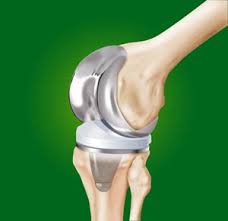Types of Knee Replacement Implants
There is confusion in the mind of the people planning to undergo knee replacement surgery about the Types of Knee Replacement Implants. There is no clear cut directive or write up on them . I will try to explain the differences between the different prosthesis.
Knee prosthesis is firstly divided between all polyethylene ( also called all poly ) and metal back prosthesis . A knee replacement prosthesis has generally 3 parts – one covering the femur , thigh bone, and is always made of metal ; second one covering the tibia , leg bone , may be made of metal or polyethylene; and the third part is fitted between these two parts , is called articular insert , and is always made of polyethylene. All poly prosthesis has tibial part and articular insert fused as one part and is of polyethylene, hence called all poly . While metal back prosthesis has a metallic tray fitted on tibia with polyethylene articular insert fitted over it . The part suffering wear and tear most in knee replacement is polyethylene. Hence , life of all poly prosthesis ( 7 – 10 years) is usually less than metal back prosthesis ( 15 – 20 years ) . But many reviews have contradicted this fact claiming the same life expectancy for both types of prosthesis.
Second difference is of metal used in manufacturing the prosthesis. It may be made of stainless steel ; of an alloy consisting of cobalt , chromium and molybdenum; and of ceramic or oxinium. Normally life expectancy of cobalt- chromium prosthesis is 15 – 20 years , while manufacturers of oxinium prosthesis claim its life expectancy of 30 years. But again a recent review has come out with the result that it’s not the type of metal of the prosthesis which decides the life expectancy of the prosthesis, but rather it’s the skill of the surgeon performing the surgery.
Third difference is the biomechanics of the prosthesis- fixed platform or rotating platform prosthesis. In fixed platform, articular insert does not rotate, but in rotating platform articular insert moves and rotates along with the movement, mimicking the normal movement of menisci , the cartilagenous plate found between the femur and tibia , inside the knee joint . The manufacturers claim that rotating platform prosthesis gives smoother, normal and painless movement. But again recent reviews have found no difference between these two types of prosthesis.
Fourth difference is based on whether posterior cruciate ligament ( PCL ) is sacrificed or retained – Cruciate retaining ( CR ) and Cruciate sacrificing ( CS ) / Posteriorly Stabilised ( PS ) prosthesis. There are two ligaments binding femur and tibia from anterior to posterior ends – Anterior Cruciate ligament ( ACL ) and Posterior Cruciate ligament ( PCL ) , providing anterior and posterior stability to the knee joint . ACL is always sacrificed in the surgery for having complete view inside the knee joint . PCL gives the normal roll back movement of femur over tibia during bending of the knee . Hence , if PCL is preserved , it provides extra stability , mimicking better and normal movement of the knee and patient is rehabilitated early . CR knee is preferred in younger patients and patients having normal disease free PCL , while PS knee is preferred in rheumatoid arthritis patients, patients having damaged or diseased PCL, obese patients or in old age patients.
Fifth difference is based on the range of movement of the operated knee achieved . Normal knee prosthesis permits the patients to bend their knees upto 120 degrees of flexion . Hiflex knee allows the patients to achieve full range of movement of the knee after the surgery and they are allowed to do even cross legged sitting later on.
Similarly there is “Gender” knee mimicking anterior shape of south east Asian females . Another is knee with personalised zigs for bony cuts. Here CT scan of the knee is done and according to the anatomical structures, personalised bone cutting zigs are manufactured by the company and delivered to the operating doctor for surgery . Most expensive knee is personalised knee prosthesis followed by Oxinium hiflex and the cheapest is all poly knee . A person should always discuss with his / her operating doctor and decide upon the type of prosthesis , based on his / her budget , requirement , age and preference .

